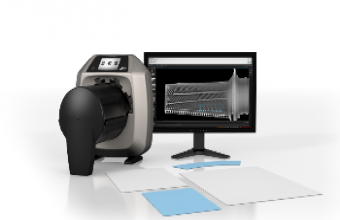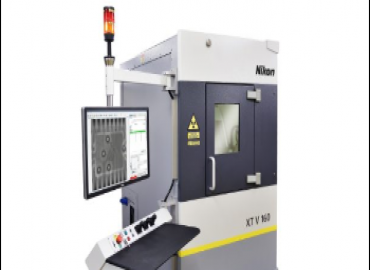Radiographic inspection is a critical inspection method in the Aerospace industry. Traditionally film based radiographic inspection was used, however, digital radiography systems are gaining popularity as a replacement for film. Computed Radiography (CR) is one example of a digital replacement for X-ray film and has many benefits for aerospace applications.
CR combines the flexibility of film with the advantages of a high-resolution digital image. CR systems are very similar to film systems; however, there are a few distinct differences between the two systems. Instead of a film, a photostimulable phosphor imaging plate (IP) is used to capture a latent image. Consumables like films, toxic chemicals, darkrooms and storage space are not required for CR image acquisition. The image is produced by running the IPs through a scanner where the latent image is digitized and then the IP is erased for immediate reuse. The digital image can then be stored on a local server or on the cloud and can be easily shared between users.
Because of these differences, CR systems are less expensive than film systems long term. Another advantage of CR radiography over film radiography is the reduction of image acquisition times. IPs have a wider dynamic range and higher sensitivity to radiation, allowing exposure times to be reduced by up to 50% compared to film. IP scan times can be as little as 30 seconds through a CR scanner as compared to film where film processing can take up to 15 minutes.
CR scanners like the HD-CR 35 NDT from DÜRR are portable and compact and inspections can be performed both in the lab and remotely without heavy and bulky equipment. The HD-CR 35 uses state-of-the-art TreFoc laser focusing technology unique to DÜRR to allow all types of radiographic inspections to be performed from applications that require high-resolution image quality from critical welds and aerospace components to applications requiring lower resolution like pipe profiles. The ability to scan a wide variety of IP sizes, or even special shapes, is also an important factor for aerospace and aircraft inspection.
The greatest advantage of CR over film is the ability to analyze and evaluate the radiographic image using an inspection software like D-Tect X. D-Tect X provides aerospace users with essential analytical tools and functions not available to the technicians with film to enable and facilitate inspection tasks to the highest standards. Another advantage to using inspection software is when the software has an integrated interface to a business management software like Drive NDT it enables fast report generation and project management.
Another type of detector being used in aerospace applications is digital detector arrays (DDAs). One huge advantage of CR over DDAs is the IP is pliable. Due to the pliability of the IP, it can be wrapped around or adapted to an object. Since the HD-CR 35 NDT scans IPs up to 35 cm wide and up to 2 m long, one is not limited in size compared to DDAs and several IPs can be exposed at the same time. The weight of an IP is only a few grams, whereas DDAs weigh several kilos making it easier for a technician to handle. In addition, with a basic spatial resolution of 30 µm, the scanner offers far better resolution than most DDAs. Especially when working with high standards, CR is often the only digital solution due to its resolution.
D-Tect X images are archived in DICONDE format and using the license-free D-Tect X Viewer, images can be viewed and analyzed with the same look and feel as the full software version. This simplifies communication and makes it easier to share results as compared to conventional film methods.
Overall, there are excellent and legitimate reasons for using CR in aerospace applications, even more so when it is such a flexible system as the HD-CR 35 NDT.
CR-Scanner HD-CR 35 with imaging plates and D-Tect X Software.
X-ray image of a turbine blade optimized using the Region of Interest (ROI) tool.












